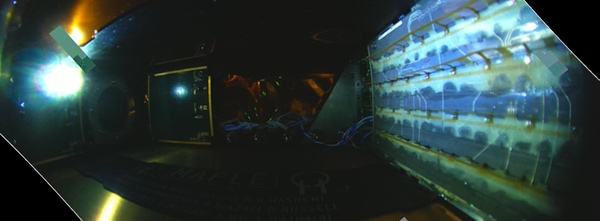Live Event: Space Based Solar Power – SpaceNews

Report on the Potential of Space-Based Solar Power for Achieving Sustainable Development Goals
An analysis of emerging energy technologies indicates that Space-Based Solar Power (SBSP) presents a significant opportunity to address global energy demands and advance key United Nations Sustainable Development Goals (SDGs). This report outlines the strategic importance of SBSP, its alignment with the 2030 Agenda for Sustainable Development, and key areas for future consideration.
SBSP as a Catalyst for Sustainable Energy
A comprehensive international assessment conducted under the auspices of the International Academy of Astronautics has affirmed the technical potential of Solar Power Satellites (SPS). The findings suggest that this technology can provide continuous, large-scale electrical power from orbit to Earth, thereby overcoming the limitations of terrestrial renewable sources, such as weather dependency and diurnal cycles.
Alignment with SDG 7: Affordable and Clean Energy
SBSP directly supports the objectives of SDG 7 by offering a novel method for generating clean, reliable, and potentially affordable energy on a global scale. Its key contributions include:
- Universal Access: By transmitting energy wirelessly, SBSP could potentially deliver power to remote and underserved regions, enhancing energy equity.
- Reliability: The constant exposure to solar radiation in space ensures an uninterrupted power supply, crucial for stable grids and industrial development.
- Clean Source: As a carbon-free energy source, SBSP can play a pivotal role in the global transition away from fossil fuels.
Broader Impacts on the Sustainable Development Agenda
The development and deployment of SBSP technology extend beyond energy, promising to catalyze progress across multiple interconnected SDGs.
Advancing SDG 9 and SDG 13
The implementation of SBSP is intrinsically linked to fostering innovation and combating climate change.
- SDG 9 (Industry, Innovation, and Infrastructure): The realization of SBSP necessitates significant advancements in aerospace engineering, robotics, and wireless power transmission, fostering a new frontier of industrial innovation and resilient infrastructure.
- SDG 13 (Climate Action): By providing a scalable, baseload clean energy alternative, SBSP can drastically reduce global carbon emissions, offering a powerful tool in the fight against climate change.
Strategic Discussion and Path Forward
A strategic briefing will be held on August 14th to conduct a thorough examination of the current landscape for Space-Based Solar Power. The session aims to explore the multifaceted aspects required to integrate this technology into the global energy portfolio and support the SDGs.
Key Topics for Discussion
- Technical challenges and the innovation roadmap.
- Economic models for viability and investment.
- Policy frameworks and international cooperation required for governance (in line with SDG 17: Partnerships for the Goals).
Scheduled Panelists
- Jason Rainbow, Senior Staff Writer and Business Intelligence Manager, SpaceNews
- John Mankins, Founder and President, Mankins Space Technology
- Karen Jones, Senior Project Leader, Center for Space Policy and Strategy, The Aerospace Corporation
- To Be Announced
Analysis of Sustainable Development Goals in the Article
1. Which SDGs are addressed or connected to the issues highlighted in the article?
The article on space-based solar power (SBSP) primarily addresses the following Sustainable Development Goals:
-
SDG 7: Affordable and Clean Energy
- The core theme of the article is the development of SBSP as a “compelling long-term solution” to meet “global energy demands.” It describes a method for delivering “continuous, large-scale electricity” and “uninterrupted power on a global scale,” which directly aligns with the goal of ensuring access to affordable, reliable, sustainable, and modern energy for all.
-
SDG 9: Industry, Innovation, and Infrastructure
- The article discusses the “technical, economic and policy landscape” of SBSP, positioning it as an innovative technological solution. The development of “solar power satellites (SPS)” represents a significant advancement in sustainable infrastructure. The text highlights the need to transform a “decades-old concept” into a “key component of the global energy portfolio,” which is central to fostering innovation and building resilient infrastructure.
-
SDG 13: Climate Action
- Although not explicitly mentioned, the article’s focus on a large-scale solar power solution implies a direct connection to climate action. By proposing an alternative to traditional energy sources that can meet growing demands without being “affected by weather or time of day,” SBSP offers a way to reduce dependence on fossil fuels, thereby mitigating climate change. Solar energy is a cornerstone of climate action strategies.
2. What specific targets under those SDGs can be identified based on the article’s content?
Based on the article’s focus, the following specific targets can be identified:
-
Under SDG 7 (Affordable and Clean Energy):
- Target 7.1: By 2030, ensure universal access to affordable, reliable and modern energy services. The article’s description of SBSP delivering “uninterrupted power on a global scale” directly supports this target.
- Target 7.2: By 2030, increase substantially the share of renewable energy in the global energy mix. The article presents SBSP as a “high-potential alternative” and a new form of renewable energy that could become a “key component of the global energy portfolio.”
- Target 7.a: By 2030, enhance international cooperation to facilitate access to clean energy research and technology. The mention of a “comprehensive international assessment completed under the International Academy of Astronautics” points to the global collaboration required to develop and deploy this technology.
-
Under SDG 9 (Industry, Innovation, and Infrastructure):
- Target 9.1: Develop quality, reliable, sustainable and resilient infrastructure… to support economic development and human well-being. The development of solar power satellites as a new energy infrastructure fits this description.
- Target 9.5: Enhance scientific research, upgrade the technological capabilities of industrial sectors in all countries… encouraging innovation. The article is centered on the need to advance the “technical, economic and policy landscape” to make SBSP a reality, which is an act of enhancing research and innovation.
-
Under SDG 13 (Climate Action):
- Target 13.2: Integrate climate change measures into national policies, strategies and planning. The adoption of a novel clean energy source like SBSP would be a significant policy and strategic measure for any country aiming to combat climate change.
3. Are there any indicators mentioned or implied in the article that can be used to measure progress towards the identified targets?
The article implies several indicators that can be used to measure progress:
-
For Target 7.1:
- The article’s goal of providing “uninterrupted power on a global scale” implies progress could be measured by Indicator 7.1.1: Proportion of population with access to electricity. The successful deployment of SBSP would aim to increase this proportion.
-
For Target 7.2:
- The proposal for SBSP to become a “key component of the global energy portfolio” directly relates to Indicator 7.2.1: Renewable energy share in the total final energy consumption. The amount of electricity generated by SBSP would be a direct measure of its contribution to this indicator.
-
For Target 7.a:
- The mention of an “international assessment” and the need to navigate the “policy landscape” implies a need for global partnership. Progress could be measured by Indicator 7.a.1: International financial flows to developing countries in support of clean energy research and development and renewable energy production, as such a project would require significant international investment and cooperation.
-
For Target 9.5:
- The discussion of advancing a “decades-old concept” into a viable technology implies a focus on innovation. Progress can be measured by Indicator 9.5.1: Research and development expenditure as a proportion of GDP, specifically tracking investment into technologies like SBSP.
4. Summary Table of SDGs, Targets, and Indicators
| SDGs | Targets | Indicators (Implied from Article) |
|---|---|---|
| SDG 7: Affordable and Clean Energy | 7.1: Ensure universal access to affordable, reliable and modern energy services. | 7.1.1: Proportion of population with access to electricity. |
| 7.2: Increase substantially the share of renewable energy in the global energy mix. | 7.2.1: Renewable energy share in the total final energy consumption. | |
| 7.a: Enhance international cooperation to facilitate access to clean energy research and technology. | 7.a.1: International financial flows and cooperation in clean energy research. | |
| SDG 9: Industry, Innovation, and Infrastructure | 9.1: Develop quality, reliable, sustainable and resilient infrastructure. | Investment in and deployment of new sustainable infrastructure like Solar Power Satellites. |
| 9.5: Enhance scientific research and encourage innovation. | 9.5.1: Research and development expenditure on new energy technologies. | |
| SDG 13: Climate Action | 13.2: Integrate climate change measures into national policies, strategies and planning. | Adoption of SBSP as a national or international policy for clean energy generation. |
Source: spacenews.com

What is Your Reaction?
 Like
0
Like
0
 Dislike
0
Dislike
0
 Love
0
Love
0
 Funny
0
Funny
0
 Angry
0
Angry
0
 Sad
0
Sad
0
 Wow
0
Wow
0



























;Resize=805#)



















































